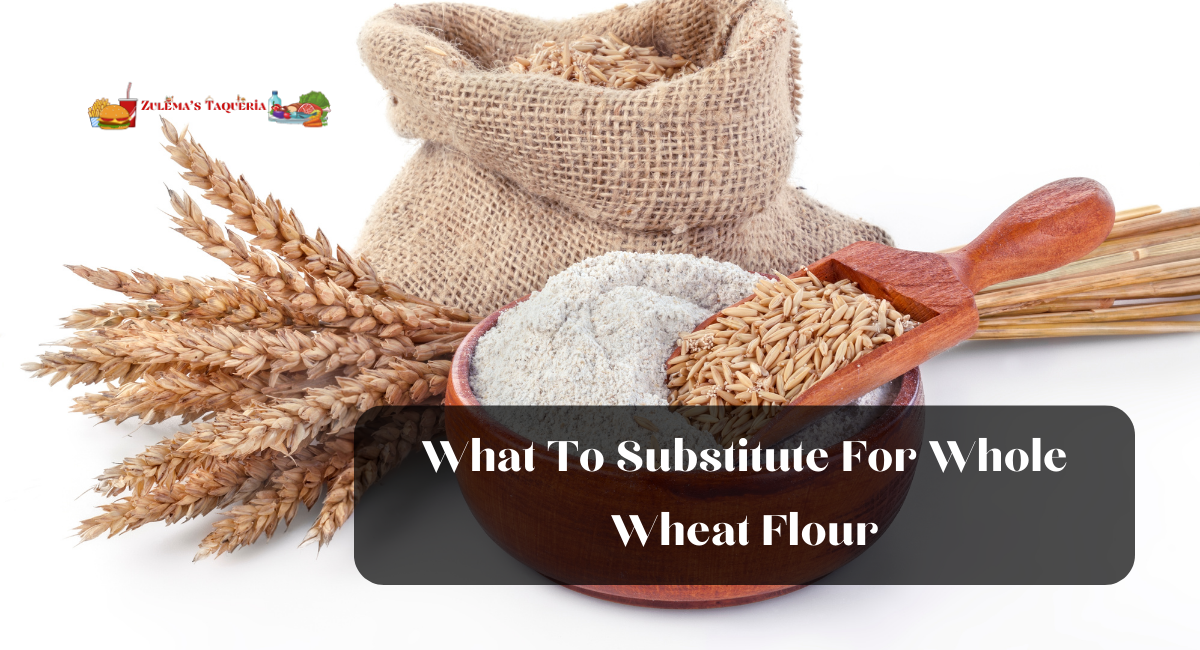Whole wheat flour is flour produced from the complete wheat kernel. It is a form of flour high in fiber and protein, making it an excellent option for baking and cooking if you desire more nutrition but still require the structure that gluten imparts to baked goods. This article,will explain what to substitute for whole wheat flour.
Understanding Whole Wheat Flour
Whole wheat flour is produced from the bran, germ, and endosperm of whole wheat grains. It contains fiber, vitamins, and minerals, making it a nutritious food. It is widely used in pastry due to its distinct nutty flavor and robust texture. Consider alternative flours based on flavor, texture, and dietary preferences when substituting.
What To Substitute For Whole Wheat Flour
If you’re out of whole wheat flour, you’re in luck because it’s simple to substitute other flours! Here are the 12 finest options.
1. Universal Flour
All-purpose flour is the most prevalent replacement for whole wheat flour. It can be used in almost any recipe for whole wheat flour, including bread, muffins, biscuits, and cakes.
All-purpose flour can be used for many things, but it doesn’t have the fiber and benefits that whole wheat flour does. Keep in mind that the texture and taste may be a little different. Whole wheat flour gives a dish a strong, spicy flavor that all-purpose flour doesn’t have.
2. White Whole Wheat Flour
White whole wheat flour is a great alternative to regular whole wheat flour when you want a milder taste and lighter texture. Most recipes that call for whole wheat flour can use this.
It retains many nutritional benefits of whole wheat but has a subtler flavor, making it more palatable to those unfamiliar with whole grain products.
3. Whole Wheat Pastry Flour
Whole wheat pastry flour is a finely ground wheat flour ideal for pastries, crepes, and muffins where a lighter and more tender texture is desired.
This flour balances whole wheat flour’s nutritional advantages and all-purpose flour’s texture.
4. Spelt Flour
Check the smoothness of your batter or dough after you’ve mixed it. It should be very close to how the original recipe was written. If you need to, add more liquid or flour to change the consistency.
Spelt flour provides a distinctive flavor profile, making it a good option to introduce variety into your recipes.
5. Oat Flour
Use oat flour in recipes that benefit from its mildly sweet, nutty flavor. It is ideal for oatmeal biscuits, pancakes, and certain bread recipes.
Oat flour imparts a distinct flavor and texture, which may not be appropriate for all recipes.
6. Almond Flour
Almond flour is an outstanding replacement for whole wheat flour in gluten-free baking. It imparts a nutty taste and is useful in recipes for cakes, biscuits, and certain breads.
Almond flour can change the taste of baked goods because it has a lot of fat in it. When using almond flour, you must change the recipe’s measurements and amount of liquid.
7. Copra Flour
Coconut flour is typically utilized in gluten-free and paleo preparations. It imparts a subtle coconut flavor to muffins, pancakes, and certain delicacies.
Coconut flour is exceedingly absorbent, so you must use less and increase the amount of liquid in your recipe. Additionally, it has a distinct texture and flavor that may not complement all recipes.
8. Durum Wheat Flour
Gluten-free chickpea flour is excellent for savory dishes such as socca (chickpea flatbread), pakoras, and specific Middle Eastern recipes.
Chickpea flour has a distinct flavor that can be overwhelming in saccharine dishes. It is essential to select recipes that complement its flavor.
9. Wheat Flour
In Asian cuisine and gluten-free cooking, rice flour is a common gluten-free ingredient. It can be used in dishes such as rice cakes, rice noodles, and certain delicacies.
Rice flour’s neutral flavor and fine texture make it a versatile ingredient in gluten-free recipes.
10. Buckwheat Flour
Buckwheat is gluten-free and imparts a robust, earthy flavor to recipes, despite its moniker. It is ideal for pancakes, crepes, and various baked products.
Buckwheat flour can be dense and typically blended with other flours for optimal results. Due to its distinct flavor, it can be acquired as a taste.
11. Einkorn Flour
Einkorn flour is produced from an ancient wheat cultivar that has not been hybridized with other wheat species. Although it contains less gluten than modern wheat, it still contains some gluten. This variety of flour has a low starch content and a high protein content.
It may require additional leavening agents, yeast, or a bread machine to adequately rise and expand. Einkorn flour is one of the lowest-calorie flours, with 100 calories per 1/4 cup, compared to 140 calories for the same amount of whole wheat flour.
12. Red Whole Wheat Flour
Red whole wheat flour typically contains more protein and antioxidants than white whole wheat flour or whole wheat blends, derived from hard red wheat kernels rich in protein (about 12-13%). This provides approximately 6 grams of protein per 1/4 cup!
Tips
- Measure Accurately: Always employ precise measurements when substituting flours. Use the same measuring containers or scales for the original and replacement whole wheat flour to ensure consistency.
- Consider Flavor Profiles: Different flours have different traits. Think about how the taste of the substitute flour will go with or against the other flavors in the dish. Almond flour gives food a grainy taste, while coconut flour gives food a mild coconut taste.
- Texture Is Important: Flour textures can vary substantially. Some flours, such as almond and coconut, are finer and may produce a more substantial end product. Others, such as oat flour, have a grainier texture. Prepare yourself for potential texture alterations in your dish.
- Gluten Content: Gluten, which is found in whole wheat flour, gives cooked goods their shape and flexibility. If you use a gluten-free flour like almond, coconut, or chickpea, you may need to add a binding agent like xanthan gum to improve the texture and structure.
- Experiment in Small Batches: If you’re unsure how a substitution will turn out, consider creating a smaller batch as a test. This allows you to make necessary adjustments to the recipe before committing to a larger quantity.
- Adjust Liquid and Fat Content: Various flours absorb liquids differently. When substituting, you may need to adjust the quantity of liquid and fat in a recipe. Gluten-free flours typically require more liquid, whereas almond flour’s higher fat content may necessitate less oil.
Thanks for reading.










